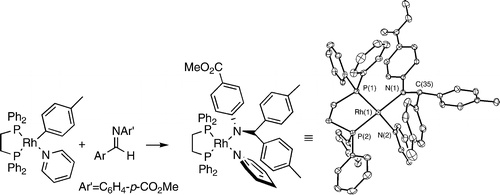Imine Insertion into a Late Metal-Carbon Bond To Form a Stable Amido Complex
J. Am. Chem. Soc., 2004, 126 (2694-2695)
View on publisher site
Abstract
An arylrhodium(I) complex containing a labile dative ligand was prepared, and its reactivity toward aryl imines was investigated. The arylrhodium(I) complex (DPPE)Rh(C5H5N)(p-tol), 2, was isolated in 65% yield from [(DPPE)Rh(μ-Cl)]2, pyridine, and p-tolyllithium. Reaction of 2 with the aldimine (p-tol)CH N(C6H4-p-CO2Me) (3a-Tol) gave the Rh amide insertion product 4 in 88% isolated yield. The solid-state structure of 4 was determined by single-crystal X-ray diffraction. The reaction of 2 with the electron-neutral and electron-rich aldimines (Ph)CH
N(C6H4-p-CO2Me) (3a-Tol) gave the Rh amide insertion product 4 in 88% isolated yield. The solid-state structure of 4 was determined by single-crystal X-ray diffraction. The reaction of 2 with the electron-neutral and electron-rich aldimines (Ph)CH NPh (3b) and (p-tol)CH
NPh (3b) and (p-tol)CH N(C6H4-p-OMe) (3c) also appeared to involve insertion, but the amido complexes formed from these insertions were not stable. Thus, reaction of 2 with 3b, followed by addition of Et3NHCl, gave the amine and ketimine products (Ph)(p-tol)CH−NHPh, 5, and (p-tol)(Ph)C
N(C6H4-p-OMe) (3c) also appeared to involve insertion, but the amido complexes formed from these insertions were not stable. Thus, reaction of 2 with 3b, followed by addition of Et3NHCl, gave the amine and ketimine products (Ph)(p-tol)CH−NHPh, 5, and (p-tol)(Ph)C N(Ph), 6, in 25% and 50% yields. Several lines of data indicate that these products are formed by a sequence of transformations involving insertion of imine to give a Rh amide intermediate, β-hydrogen elimination, cyclometalation to form a bound imine and H2, and protonolysis of the metallacycle upon addition of Et3NHCl. Consistent with this proposal, the proposed metallacycle containing the ortho-metalated ketimine ligand (p-tol)2C
N(Ph), 6, in 25% and 50% yields. Several lines of data indicate that these products are formed by a sequence of transformations involving insertion of imine to give a Rh amide intermediate, β-hydrogen elimination, cyclometalation to form a bound imine and H2, and protonolysis of the metallacycle upon addition of Et3NHCl. Consistent with this proposal, the proposed metallacycle containing the ortho-metalated ketimine ligand (p-tol)2C N(C6H4-p-OMe) was isolated and characterized by single-crystal X-ray diffraction.
N(C6H4-p-OMe) was isolated and characterized by single-crystal X-ray diffraction.
Read on publisher's site
 N(C6H4-p-CO2Me) (3a-Tol) gave the Rh amide insertion product 4 in 88% isolated yield. The solid-state structure of 4 was determined by single-crystal X-ray diffraction. The reaction of 2 with the electron-neutral and electron-rich aldimines (Ph)CH
N(C6H4-p-CO2Me) (3a-Tol) gave the Rh amide insertion product 4 in 88% isolated yield. The solid-state structure of 4 was determined by single-crystal X-ray diffraction. The reaction of 2 with the electron-neutral and electron-rich aldimines (Ph)CH NPh (3b) and (p-tol)CH
NPh (3b) and (p-tol)CH N(C6H4-p-OMe) (3c) also appeared to involve insertion, but the amido complexes formed from these insertions were not stable. Thus, reaction of 2 with 3b, followed by addition of Et3NHCl, gave the amine and ketimine products (Ph)(p-tol)CH−NHPh, 5, and (p-tol)(Ph)C
N(C6H4-p-OMe) (3c) also appeared to involve insertion, but the amido complexes formed from these insertions were not stable. Thus, reaction of 2 with 3b, followed by addition of Et3NHCl, gave the amine and ketimine products (Ph)(p-tol)CH−NHPh, 5, and (p-tol)(Ph)C N(Ph), 6, in 25% and 50% yields. Several lines of data indicate that these products are formed by a sequence of transformations involving insertion of imine to give a Rh amide intermediate, β-hydrogen elimination, cyclometalation to form a bound imine and H2, and protonolysis of the metallacycle upon addition of Et3NHCl. Consistent with this proposal, the proposed metallacycle containing the ortho-metalated ketimine ligand (p-tol)2C
N(Ph), 6, in 25% and 50% yields. Several lines of data indicate that these products are formed by a sequence of transformations involving insertion of imine to give a Rh amide intermediate, β-hydrogen elimination, cyclometalation to form a bound imine and H2, and protonolysis of the metallacycle upon addition of Et3NHCl. Consistent with this proposal, the proposed metallacycle containing the ortho-metalated ketimine ligand (p-tol)2C N(C6H4-p-OMe) was isolated and characterized by single-crystal X-ray diffraction.
N(C6H4-p-OMe) was isolated and characterized by single-crystal X-ray diffraction.